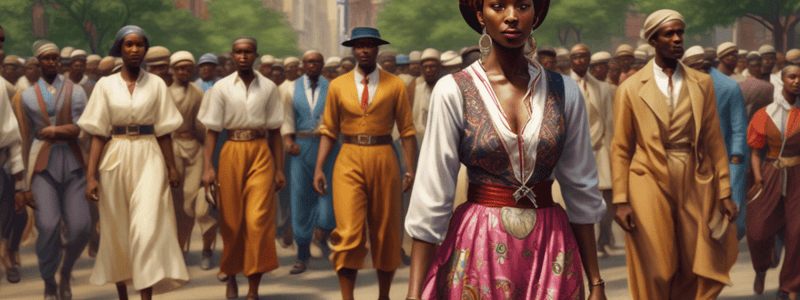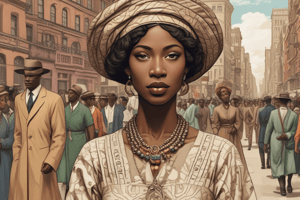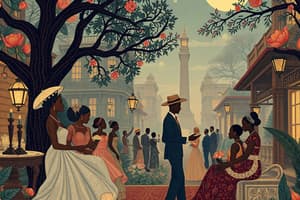Podcast
Questions and Answers
What was the primary factor that led to the Harlem Renaissance?
What was the primary factor that led to the Harlem Renaissance?
- Improved education and housing opportunities in the North
- The rise of the KKK after World War I
- The Great Migration of African Americans from the South to the North (correct)
- The end of slavery and the Reconstruction era
What was the primary reason African Americans left the South during the Great Migration?
What was the primary reason African Americans left the South during the Great Migration?
- To take advantage of better job opportunities in the North
- To join the growing war industries in the North
- To escape the racism and violence they faced in the South (correct)
- To pursue higher education in northern cities
What were the 'Black Codes' that limited the lives of newly freed slaves?
What were the 'Black Codes' that limited the lives of newly freed slaves?
- Regulations that restricted the movement and activities of black people in the South
- Racist laws that allowed for the public execution of black people without due process
- Policies that prevented black people from accessing education and housing
- Laws that defined the jobs they could have and how much they could be paid (correct)
Which of the following were not a factor in the Harlem Renaissance?
Which of the following were not a factor in the Harlem Renaissance?
How did racism manifest differently in the North compared to the South during this time period?
How did racism manifest differently in the North compared to the South during this time period?
What was the significant theme of the Harlem Renaissance as reflected in Claude McKay's poem 'If We Must Die'?
What was the significant theme of the Harlem Renaissance as reflected in Claude McKay's poem 'If We Must Die'?
Which book laid the foundation for the intellectual ideas of the Harlem Renaissance according to the text?
Which book laid the foundation for the intellectual ideas of the Harlem Renaissance according to the text?
Who was nicknamed the 'Dean' of the Harlem Renaissance?
Who was nicknamed the 'Dean' of the Harlem Renaissance?
Which musician from the Harlem Renaissance era is known for popularizing Jazz and influencing modern musical genres like rock and blues?
Which musician from the Harlem Renaissance era is known for popularizing Jazz and influencing modern musical genres like rock and blues?
Which organization set up tools and practices that were valuable during the civil rights movement of the 1950s and 60s?
Which organization set up tools and practices that were valuable during the civil rights movement of the 1950s and 60s?
What was a common theme in the artwork of the Harlem Renaissance?
What was a common theme in the artwork of the Harlem Renaissance?
What was the significance of Meta Vaux Warrick Fuller's sculpture "Ethiopia Awakening"?
What was the significance of Meta Vaux Warrick Fuller's sculpture "Ethiopia Awakening"?
Which statement about jazz music during the Harlem Renaissance is true?
Which statement about jazz music during the Harlem Renaissance is true?
Which of the following statements about the Cotton Club is NOT true?
Which of the following statements about the Cotton Club is NOT true?
What was significant about Langston Hughes' work during the Harlem Renaissance?
What was significant about Langston Hughes' work during the Harlem Renaissance?
Flashcards are hidden until you start studying
Study Notes
The Harlem Renaissance
- The Harlem Renaissance was an African American artistic, cultural, and intellectual movement that originated in the 1920s in Harlem, New York.
- The Great Migration of African Americans from the South to northern cities like New York, Chicago, Cleveland, and St. Louis in the 1910s contributed to the movement.
Reasons for the Great Migration
- African Americans fled the South to escape racism, violence, and terrorism, including lynching and intimidation by the KKK.
- They sought better education, housing, and employment opportunities in the North.
- Jobs in the war industries during WWI also attracted African Americans to northern cities.
Racism in the South
- Lynching was common, with white mobs accusing African Americans of crimes they did not commit, with no due process, and publicly executing them.
- Black codes and Jim Crow laws restricted the lives of African Americans, limiting their jobs, work hours, and pay.
Harlem Renaissance Art and Literature
- The movement was also known as the New Negro Movement, coined by Alain Leroy Locke.
- The movement demanded equal civil rights and sought to create a new perception of African American culture.
- Artists, writers, and musicians like Langston Hughes, Zora Neale Hurston, and Louis Armstrong expressed themes of African heritage, racism, and equality.
Notable Artists and Artwork
- Meta Vaux Warrick Fuller's sculpture "Ethiopia Awakening" symbolized rebirth and tied African culture to Egyptian imagery.
- James Van Der Zee's photography captured daily life in Harlem.
- Augusta Savage's sculptures portrayed everyday black Americans, including her famous work "Gamin".
Jazz and the Harlem Renaissance
- Jazz was an innovative musical style that rejected convention and was popularized by black artists.
- Initially resisted by middle-class African Americans, jazz eventually gained acceptance as a symbol of upper-class culture.
- Famous jazz musicians included Louis Armstrong, Duke Ellington, Bessie Smith, and Ma Rainey.
Legacy of the Harlem Renaissance
- The movement influenced the Civil Rights Movement and continues to impact modern music, art, and literature.
- Organizations like the NAACP, founded by W.E.B. Du Bois, continue to promote social and political change.
Studying That Suits You
Use AI to generate personalized quizzes and flashcards to suit your learning preferences.




